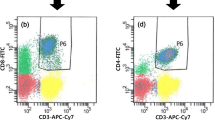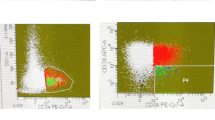Abstract
Background
Recently, identification of CD25 (interleukin-2 receptor alpha) expression on leukemic blasts was correlated to early treatment failure and unfavorable outcome in acute myeloid leukemia (AML) patients. Here we wished to determine whether quantification of CD25 on peripheral blood CD4+ T cells could improve prognostication in newly diagnosed AML patients.
Methods
The mean fluorescence intensity (MFI) of CD25 expression and frequencies of peripheral blood CD4+ T cells with varying levels of CD25 and CD127 expression were assessed by flow cytometry in all studied individuals.
Results
Using univariate (unadjusted) and multivariate (adjusted) analyses we demonstrated that detection of high pretreatment CD25 expression on circulating CD4+ T cells was associated with significantly decreased survival rate of AML patients subjected to standard induction chemotherapy. These associations held true for both entire group of analyzed AML patients and different subgroups of patients identified by presence or absence of favorable and adverse molecular prognostic factors.
Conclusions
Our data indicate that quantification of CD25 expression on peripheral blood CD4+ T cells could become a novel, easily accessible method of shortened survival prognostication of AML patients subjected to standard cytotoxic therapy.
Similar content being viewed by others
References
Cerny J, Yu H, Ramanathan M, Raffel GD, Walsh WV, Fortier N, et al. Expression of CD25 independently predicts early treatment failure of acute myeloid leukaemia (AML). Br J Haematol 2013;160(2):262–6.
Terwijn M, Feller N, van Rhenen A, Kelder A, Westra G, Zweegman S, et al. Interleukin-2 receptor alpha-chain (CD25) expression on leukaemic blasts is predictive for outcome and level of residual disease in AML. Eur J Cancer 2009;45(9):1692–9.
Gönen M, Sun Z, Figueroa ME, Patel JP, Abdel-Wahab O, Racevskis J, et al. CD25 expression status improves prognostic risk classification in AML independent of established biomarkers: ECOG phase 3 trial, E1900. Blood 2012;120(11): 2297–306.
Moniuszko M, Grubczak K, Kowal K, Eljaszewicz A, Rusak M, Jeznach M, et al. Development of asthmatic response upon bronchial allergen challenge is associated with dynamic changes of interleukin-10-producing and interleukin-10-responding CD4+ T cells. Inflammation 2014;37(6):1945–56.
Chen W, Jin W, Hardegen N, Lei KJ, Li L, Marinos N, et al. Conversion of peripheral CD4+CD25− naive T cells to CD4+CD25+ regulatory T cells by TGF-beta induction of transcription factor Foxp3. J Exp Med 2003;198:1875–86.
Nacsa J, Edghill-Smith Y, Tsai WP, Venzon D, Tryniszewska E, Hryniewicz A, et al. Contrasting effects of low-dose IL-2 on vaccine-boosted simian immunodeficiency virus (SIV)-specific CD4+ and CD8+ T cells in macaques chronically infected with SlVmac251. J Immunol 2005;174(4):1913–21.
Bossowski A, Moniuszko M, Dąbrowska M, Sawicka B, Rusak M, Jeznach M, et al. Lower proportions of CD4+CD25(high) and CD4+FoxP3, but not CD4+CD25+CD127(low) FoxP3+ T cell levels in children with autoimmune thyroid diseases. Autoimmunity 2013;46(3):222–30.
Hashemi BB, Penkala JE, Vens C, Huls H, Cubbage M, Sams CF. T cell activation responses are differentially regulated during clinorotation and in spaceflight. FASEB J 1999;13(14):2071–82.
Takahashi T, Tagami T, Yamazaki S, Uede T, Shimizu J, Sakaguchi N, et al. Immunologic self-tolerance maintained by CD25(+)CD4(+) regulatory T cells constitutively expressing cytotoxic T lymphocyte-associated antigen 4. J Exp Med 2000;192(2):303–10.
Shevach EM. CD4+ CD25+ suppressor T cells: more questions than answers. Nat Rev Immunol 2002;2(6):389–400.
Maloy KJ, Powrie F. Regulatory T cells in the control of immune pathology. Nat Immunol 2001;2(9):816–22.
Moniuszko M, Kowal K, Zukowski S, Dabrowska M, Bodzenta-Lukaszyk A. Frequencies of circulating CD4+CD25+CD127low cells in atopics are altered by bronchial allergen challenge. Eur J Clin Invest 2008;38(3):201–4.
Vignali DA, Collison LW, Workman CJ. How regulatory T cells work. Nat Rev Immunol 2008;8(7):523–32.
Zhao DM, Thornton AM, DiPaolo RJ, Shevach EM. Activated CD4+CD25+ T cells selectively kill B lymphocytes. Blood 2006;107(10):3925–32.
Triplett TA, Curti BD, Bonafede PR, Miller WL, Walker EB, Weinberg AD. Defining a functionally distinct subset of human memory CD4+ T cells that are CD25POS and FOXP3NEG. Eur J Immunol 2012;42(7):1893–905.
Vardiman JW, Thiele J, Arber DA, Brunning RD, Borowitz MJ, Porwit A, et al. The 2008 revision of the World Health Organization (WHO) classification of myeloid neoplasms and acute leukemia: rationale and important changes. Blood 2009;114(5):937–51.
Holowiecki J, Grosicki S, Giebel S, Robak T, Kyrcz-Krzemien S, Kuliczkowski K, et al. Cladribine, but not fludarabine, added to daunorubicin and cytarabine during induction prolongs survival of patients with acute myeloid leukemia: a multicenter, randomized phase III study. J Clin Oncol 2012;30(20):2441–8.
Cheson BD, Bennett JM, Kopecky KJ, Büchner T, Willman CL, Estey EH, et al. Revised recommendations of the International Working Group for Diagnosis, Standardization of Response Criteria, Treatment Outcomes, and Reporting Standards for Therapeutic Trials in Acute Myeloid Leukemia. J Clin Oncol 2003;21(24):4642–9.
Hoffmann HJ, Malling TM, Topcu A, Ryder LP, Nielsen KR, Varming K, et al. CD4dimCD25bright Treg cell frequencies above a standardized gating threshold are similar in asthmatics and controls. Cytometry A 2007;71(6): 371–8.
Bacher U, Haferlach T, Alpermann T, Kern W, Schnittger S, Haferlach C. Molecular mutations are prognostically relevant in AML with intermediate risk cytogenetics and aberrant karyotype. Leukemia 2013;27(2):496–500.
Mrózek K, Marcucci G, Paschka P, Whitman SP, Bloomfield CD. Clinical relevance of mutations and gene-expression changes in adult acute myeloid leukemia with normal cytogenetics: are we ready for a prognostically prioritized molecular classification? Blood 2007;109(2):431–48.
Chiou SH, Sheu BC, Chang WC, Huang SC, Hong-Nerng H. Current concepts of tumor-infiltrating lymphocytes in human malignancies. J Reprod Immunol 2005;67(1–2):35–50.
Farag SS, George SL, Lee EJ, Baer M, Dodge RK, Becknell B, et al. Postremission therapy with low-dose interleukin 2 with or without intermediate pulse dose interleukin 2 therapy is well tolerated in elderly patients with acute myeloid leukemia: Cancer and Leukemia Group B Study 9420. Clin Cancer Res 2002;8(9):2812–9.
Stein AS, O’Donnell MR, Slovak ML, Snyder DS, Nademanee AP, Parker P, et al. Interleukin-2 after autologous stem-cell transplantation for adult patients with acute myeloid leukemia in first complete remission. J Clin Oncol 2003;21(4):615–23.
Ganser A, Heil G, Seipelt G, Hofmann W, Fischer JT, Langer W, et al. Intensive chemotherapy with idarubicin, ara-C, etoposide, and m-AMSA followed by immunotherapy with interleukin-2 for myelodysplastic syndromes and high-risk Acute Myeloid Leukemia (AML). Ann Hematol 2000;79(1):30–5.
Pautas C, Merabet F, Thomas X, Raffoux E, Gardin C, Corm S, et al. Randomized study of intensified anthracycline doses for induction and recombinant interleukin-2 for maintenance in patients with acute myeloid leukemia age 50–70 years: results of the ALFA-9801 study. J Clin Oncol 2010;28(5): 808–14.
Baer MR, George SL, Caligiuri MA, Sanford BL, Bothun SM, Mrózek K, et al. Low-dose interleukin-2 immunotherapy does not improve outcome of patients age 60 years and older with acute myeloid leukemia in first complete remission: Cancer and Leukemia Group B Study 9720. J Clin Oncol 2008;26(30):4934–9.
Lange BJ, Smith FO, Feusner J, Barnard DR, Dinndorf P, Feig S, et al. Outcomes in CCG-2961, a children’s oncology group phase 3 trial for untreated pediatric acute myeloid leukemia: a report from the children’s oncology group. Blood 2008;111(3):1044–53.
Buyse M, Squifflet P, Lange BJ, Alonzo TA, Larson RA, Kolitz JE, et al. Individual patient data meta-analysis of randomized trials evaluating IL-2 monotherapy as remission maintenance therapy in acute myeloid leukemia. Blood 2011;117(26):7007–13.
Kolitz JE, George SL, Benson DM, Maharry K, Marcucci G, Vij R, et al. Recombinant interleukin-2 in patients aged younger than 60 years with acute myeloid leukemia in first complete remission: results from Cancer and Leukemia Group B 19808. Cancer 2014;120(7):1010–7.
Baecher-Allan C, Brown JA, Freeman GJ, Hafler DA. CD4+CD25high regulatory cells in human peripheral blood. J Immunol 2001;167(3):1245–53.
Moniuszko M, Glowinska-Olszewska B, Rusak M, Jeznach M, Grubczak K, Lipinska D, et al. Decreased CD127 expression on CD4+ T-cells and elevated frequencies of CD4+CD25+CD127− T-cells in children with long-lasting type 1 diabetes. Clin Dev Immunol 2013;2013:459210.
Szczepanski MJ, Szajnik M, Czystowska M, Mandapathil M, Strauss L, Welsh A, et al. Increased frequency and suppression by regulatory T cells in patients with acute myelogenous leukemia. Clin Cancer Res 2009;15(10):3325–32.
Ustun C, Miller JS, Munn DH, Weisdorf DJ, Blazar BR. Regulatory T cells in acute myelogenous leukemia: is it time for immunomodulation? Blood 2011;118(19):5084–95.
Author information
Authors and Affiliations
Corresponding author
Rights and permissions
About this article
Cite this article
Bołkun, Ł., Rusak, M., Eljaszewicz, A. et al. Enhanced pretreatment CD25 expression on peripheral blood CD4+ T cell predicts shortened survival in acute myeloid leukemia patients receiving induction chemotherapy. Pharmacol. Rep 68, 12–19 (2016). https://doi.org/10.1016/j.pharep.2015.05.025
Received:
Revised:
Accepted:
Published:
Issue Date:
DOI: https://doi.org/10.1016/j.pharep.2015.05.025




